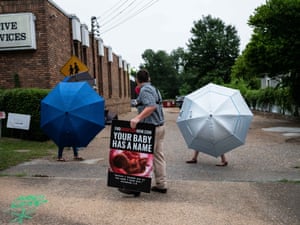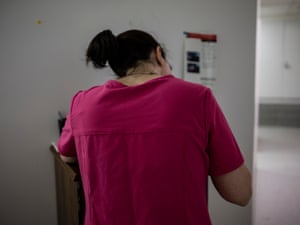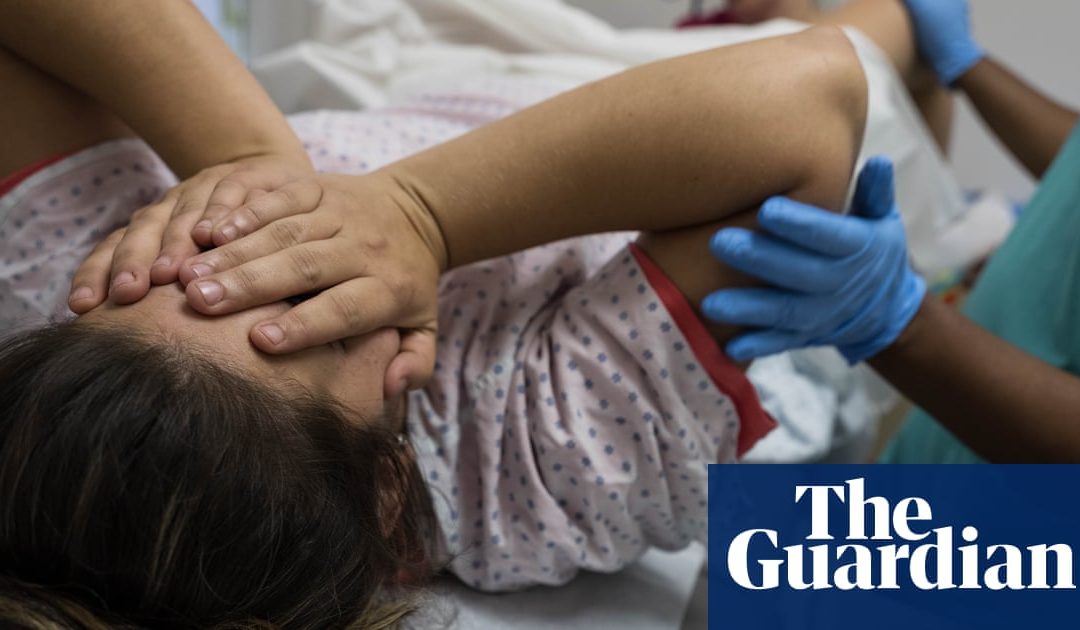Rachel is a doctor who provides abortions. She commutes 10 hours each way to work in an area of Alabama that would otherwise not provide the procedure at all

Rachel hunches down in the seat of a Chevrolet rental, adjusting her disguise in the mirror. She pulls down a fedora to partly cover her face, but isnt convinced it offers enough cover. She puts on a pair of oversize sunglasses.
While the combination conceals her face, it is also not an inconspicuous sight in the pre-dawn Friday hours in a run-down neighborhood in Montgomery, Alabama.
I feel like I should have a fake mustache, she says. What do you think?
Rachel is a doctor who provides abortions, and if recent history is any guide, a disguise may not be a bad idea. Since 1993, anti-choice extremists in the US have killed 11 people, including four doctors.
Performing abortions can put a serious dent in doctors careers; many have been banned, fired or have had job offers rescinded. Fearing for their safety, some doctors have even made the decision to arm themselves. For those reasons, abortion clinics struggle to find local doctors willing to assume those risks.
This is the American reality that forces medical professionals to travel hundreds of miles in order to provide basic healthcare to women.
Alabama recently passed one of the most draconian abortion laws in the country, which would have made it a crime for doctors to perform abortions during any stage of the pregnancy unless the womans life was in danger. The law has been challenged in court, and as of now, abortions are legal before 20 weeks in Alabama.
The state is one of nine to recently pass restrictive abortion bans as an emboldened evangelical right seek to challenge access to abortion. Although none of the bans are currently in effect, they are designed to place pressure on Roe v Wade, the supreme court decision that enshrined a womans legal right to abortion.
Rachel gets up at dawn and takes her family on a train to the airport. She then flies to Atlanta, picks up a rental car and drive two hours to Montgomery. The next day, when her work is over, she retraces her steps. Commuting takes 10 hours each way, and there are times when its 2am before shes back in her own bed.
Under the weight of relentless attacks from state legislatures, the number of clinics providing abortion has been falling for decades. In the south and the midwest, the number of clinics fell by 13% and 22% respectively between 2011 and 2014. The situation is so dire that some states Missouri, West Virginia, Mississippi, Kentucky, South and North Dakota now have only one working abortion clinic.
4am
While Rachel and her toddler daughter are still sleeping, the ecosystem of protesters, clinic escorts and patients that surrounds the clinic comes to life.
At the hotel the previous evening, Rachel had told me she chose her line of work when she realized family planning was an underserved area of medicine. According to a 2013 study, only 54% of 161 sampled residency programs for obstetrics and gynecologyoffer routine abortion training.
I dont know how many lectures we had on Crohns disease in med school, she said. And its a devastating disease, but only something like 40,000 people in the US get diagnosed per year.
The lack of attention pissed me off enough to want to specialize in this, she said. I thought that I could help train the next generation after me.
Back at the clinic, Mia Raven opens a can of Dr Pepper, trying to jolt herself awake. The night before, the clinic worker had texted Rachel to warn her she would have 43 patients the next day. A couple of years ago, the clinics average was 15 patients in a day; 43 would have seemed inconceivable. But as more clinics are forced to close, it is becoming standard.
The clinic, Reproductive Health Services, only performs abortions on Fridays due to the lack of doctors and the legal hoops the state of Alabama makes patients go through. This includes a mandatory 48 hours wait period after their first consultation, when women are informed not only about the risks posed by abortion (which are negligible in the first trimester) but also alternatives to abortion. Alabama law also mandates that patients be given packets of medically inaccurate information.
The Catholic protesters who are present today are fairly unobtrusive. They have no posters of fetuses, no bullhorns and theyre not harassing patients and caregivers. They mumble their rosaries quietly with their backs to the clinic and shuffle off, their knees leaving dark depressions on the dewy grass.
While Catholics are the original anti-abortion activists in America, evangelicals have now overtaken them in raucousness.
One of them is David Day, a stocky man in his mid-50s. He is a regular and has been protesting against abortion almost weekly for the past five years. While the Catholics pray, Day straps a GoPro camera to his chest and puts out signs warning of various forms of death and hellfire for sinners. He also has a small, plastic cone to preach through, a sun hat and plenty of water.
Ive had no luck with this whatsoever, he says, spying for movement in the clinic parking lot. By Gods grace I come out here and preach the Gospel and try not to lose my mind from the evilness that goes on in there.

5am
A white RV with the words Image Clear Ultrasound painted on the side parks across the street. Inside are Amanda Jones and Ed Gannon, volunteers with Life on Wheels, a local anti-abortion ministry run by gynecologist Matthew E Phillips.
While appearing to be a mobile sonogram center, the RV is designed to dissuade women from having abortions by showing them images of the embryo.
All over the country, anti-choice activists use these so-called crisis pregnancy centers to lure women in by presenting themselves as medical clinics. Heartbeat International, formerly called Alternatives to Abortion International, runs a network of 1,800 centers around the world; their vision is to make abortion unwanted today and unthinkable for future generations. Life on Wheels claims on its website that it aims to serve women, save babies and share Jesus.
The centers have been accused of misleading women who come to them for help, in many cases spreading debunked myths about the health risks associated with abortion, including mental illness, infertility and breast cancer.
We dont say [abortion] is an alternative, says Jones, manager of mobile operations at Life on Wheels. We inform them about the abortion procedure. We educate them about the process, but we dont believe thats a good option.
The law says that the woman has to take an ultrasound at the clinic, Gannon says. But weve heard that they tell the woman that they dont have to look at it, or if they do, that its a little grainy picture. He points at a massive flat screen mounted to the wall. We show them their babies right here on the big screen. We show them the truth.
6am
Rachel sinks further down in the seat and peers out the window through her sunglasses. She checks her phone again for instructions from Mia, who has promised to keep her updated about safe routes to the clinics. Mia never takes the same drive two days in a row, always checks her car for explosives, and rarely leaves the house unarmed.
As the car approaches the clinic, there is still no word. Rachel is nervous. Were sitting ducks just idling here, she says, taking the car for another lap around the block. After a few minutes, she pulls up in the parking lot.
Some women have been here since last night, their cars windows steamy from sleeping occupants. A door opens and a woman gets out, gingerly stretching her joints from a night spent sleeping in the passenger seats. Some of the patients have come from as far away as the Florida panhandle or the Mississippi coast. Having to travel that far presents a massive hurdle to lower-income women, as many have to take several days off work, travel hundreds of miles and stay at a hotel, on top of the $600 an abortion costs and that only certain health insurance plans cover.
Inside the clinic, June Ayers, the clinic director, has started registering the days patients. The interior of the building is a labyrinthine system of small rooms designed to keep the patients moving as quickly and as painlessly through the day.
A girl in her late teens, one of the first patients of the day, enters with tears streaming down her face. She has been harangued by David Day on the way from the parking lot. His begging her not to kill her child that it is a sin and that the fetus in her belly is a baby who loves her has terrified her. Ayers offers her a piece of candy and assures her that she is safe.
Thats blood in the water to them, Ayers says as the girl sits down, referring to Day and the other protesters outside. They love tears. They think it is evidence that women dont really want to have an abortion. Which is true, I guess. Nobody wants an abortion. But they happen and were here to help women through a difficult situation.
7am
Throughout the clinic, women are waiting. The vast majority of abortions that are scheduled for today as well as the vast majority of abortions in America are first trimester abortions. The CDC estimates that 92% of abortions are performed in the first 13 weeks of a pregnancy.
Most abortions of this kind are vacuum aspiration abortions, where gentle suction is used to empty a womans uterus. While uncomfortable, the risks associated with the procedure are negligible.
For all of the women, an abortion is far safer than going through with childbirth. One patient waiting that day, Patricia from Prattville, suffered a broken pelvis and massive blood loss last time she gave birth. Its like they just want to sit back and watch who dies first, you or the kid, she says. I cant just die giving birth. Whos going to take care of my kids?
Another woman who declines to give a name already has two kids and says that there is no way she can afford a third.

Rachel works predominantly out of two rooms that are continuously occupied by patients. In the hallway between the rooms is a small podium where relevant medical records are placed so that Rachel can work as quickly as possible. She makes pleasant small talk with those patients who feel like talking.
When its over, the patient goes to recovery and the tissue gets sent to a lab for testing. Several states have lobbied for funeral services laws, arguing that aborted tissue constitutes remains and should be treated as such. One of these laws was recently struck down in Texas, but it hasnt stopped activists in Montgomery from holding regular funeral services for aborted fetuses.
10am
As the clinic settles in to its rhythm, the protesters, clinic escorts and family of the patients settle into theirs. Inside the Power House, a ramshackle old home next to the clinic used by clinic escorts and pro-choice activists, kids are watching cartoons while family and friends wait for their loved ones to come out of the clinic. They smoke cigarettes, drink coffee and get into arguments with the handful of protesters.
The clinic escorts, who tolerate the protesters with an air of amused indifference, know better than to engage.
Youre a messenger of Satan, Daniel, a protester, shouts at no one in particular.
Do you read the Bible? one of the protesters goads a woman who is sitting on the porch, waiting for her turn in the clinic.
I do. I bet I know it better than you, she says, as one of the clinic escorts tells her that its not worth taking the bait.
How often do you read it? the protester says.
Every day.
Well I read it at least twice a day.
The police officer posted outside the clinic shakes his head. David Day launches into a tirade about all the grateful women who have thanked him for stopping them, and a clinic escorts blocks his view with an umbrella and puts Lilly Allens Fuck You (Very Much) on the stereo, drowning him out.
Eventually the summer heat climbs into the high 90s and Day saves his strength, keeping quiet and hydrated for those moments when a door opens and he springs into action. Madam, please dont do this. Think of the beautiful baby. Soon, it becomes so hot that even Day barely bothers getting up. Most of the other protesters give up in the midday sun.
2pm
The day is over. Rachel has performed 37 procedures, two of them second trimester. For this type of abortion, doctors use a slightly more elaborate procedure known as dilate and evacuate, where they use tools to extract the tissue.
It is a procedure that anti-choice activists have been trying to ban for years, arguing in graphic terms that it is killing viable children. Alabama passed a law in 2016 to ban the procedures, but it was struck down and recently the supreme court declined to hear the case to restore it. (Trump himself has described so-called late term abortions a scientifically unfounded term as allowing children to be ripped from their mothers womb right up until the moment of birth.).
Finally, Rachel comes out of the clinic. Shes meeting her family for lunch across town. June Ayers, the director, has given her a book for her daughter. We love Rachel here, she says. Everyone knows and loves her family. Her kid practically grew up with us.

While activists and politicians battle for who has the right to control a womans body, the clinic and Rachel do the work, offering help to women who need it. For all of them it is about activism, more than just providing a needed service. June Ayers used to lobby her local politicians, but says she now prefers just to work at the clinic, hoping they will be allowed to stay open.
I try my best to avoid the legislative process, she says. For years I went down there, I lobbied and did what I was supposed to do, but I dont have the heart for it any more. I love my patients and I love my clinic. The two things I need when I leave the legislature are a bath and a drink.
Support for the photography was provided by The Aftermath Project.
-
This article was amended on 24 July 2019 to correct a typo and the number of people who are diagnosed with Crohns disease per year in the US and make clear the law in Alabama has been challenged in court, not struck down.
Read more: https://www.theguardian.com/world/2019/jul/24/abortion-wars-alabama-12-hours-besieged-clinic


Recent Comments